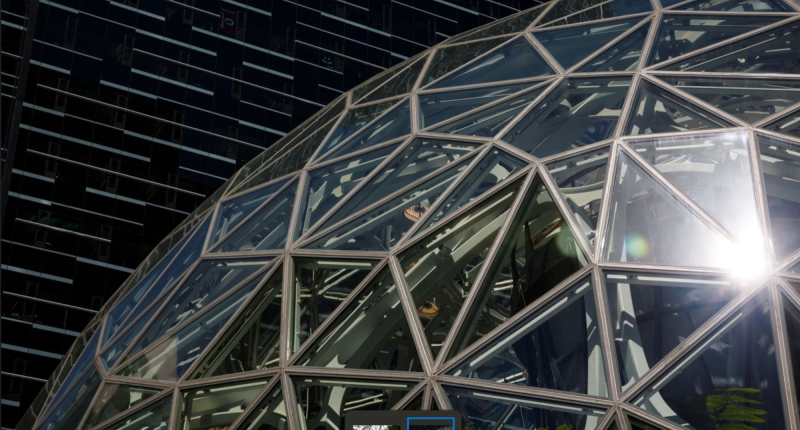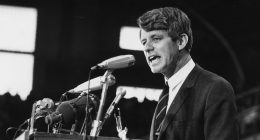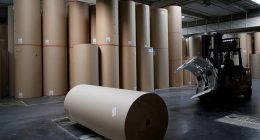Opinions expressed by Entrepreneur contributors are their own.
You’re reading Entrepreneur Middle East, an international franchise of Entrepreneur Media.
Amazon has come a long way from its humble beginnings in the garage of Jeff Bezos’ rented home in Bellevue, Washington. Today, the mammoth multinational company is often referred to as one of the most influential economic and cultural forces in the world. With its focus on e-commerce, cloud computing, digital streaming, artificial intelligence, and sustainability, Amazon has also emerged as an industry leader in the global quest to curb climate change.
In 2019, Amazon co-founded The Climate Pledge with Global Optimism (the purpose-driven enterprise focused on social and environmental change founded in 2017 by Tom Rivett-Carnac and Christiana Figueres after the pair departed the United Nations, after having successfully secured the historic Paris Agreement on Climate Change), and it then became the first company to sign the pledge, which outlines a commitment to reach net-zero carbon by 2040. Signatories to The Climate Pledge agree to regularly measure and report greenhouse gas (GHG) emissions, implement decarbonization strategies in line with the Paris Agreement, and neutralize any remaining emissions with credible offsets to achieve net-zero by 2040.
It thus brings together the world’s top companies to accelerate joint action, cross-sector collaboration and responsible change. A series of technological advancements have positioned Amazon to not only meet The Climate Pledge, but to also serve as a catalyst for its partners and industry counterparts to do the same. Here’s one example of how the company is furthering sustainability in its operations.
Amazon relies on a complex transportation network to get products from manufacturers and sellers to customers around the globe. Today, the company is decarbonizing every step of the journey -which ranges from global transportation between factories and ports, to last mile delivery between delivery stations and customers- by increasing fleet efficiency, expanding the use of low-carbon fuels, and scaling electric and alternative-fuel vehicles. Inbound transportation is the first leg of this journey, and it essentially refers to shipments across international borders.
Besides increasing its use of biofuels for this purpose, Amazon is also scaling back air freight in favor of ocean freight (which has lower carbon intensity) to reduce carbon emissions in this phase of transport. Another area of interest is middle mile transportation, which is the movement of shipments between Amazon facilities, particularly covering long-haul distances. While trucking is a challenging area to decarbonize, Amazon is up for the challenge, with it experimenting with lower carbon options such as trucks powered by renewable natural gas, electric battery trucks, as well as hydrogen-powered trucks.
Finally, we have last mile transportation, which is where Amazon has made its greatest strides towards The Climate Pledge. This refers to the final part of the journey when products are transported to the customer. Here, Amazon is working to decarbonize its last mile fleet by utilizing lower emission options such as electric delivery vehicles and electric cargo bikes.
While speaking about the company’s logistical transformation at this year’s edition of Amazon’s annual Delivering the Future event in Seattle, Washington, Udit Madan, Vice President of Transportation, also noted that all companies can and should take a leading role in climate action, because no one company can solve this crisis on their own. “We’re working with new companies who have technologies that will allow us to innovate, and often times, those companies are Climate Pledge signatories such as Orsted, Rivian, and Maersk,” Madan said. “There is a lot of groundbreaking work being done to electrify our last mile fleet. Just a few years ago, we established a partnership with Rivian to bring 100,000 custom electric delivery vans to the road by 2030. That idea, and what started as a simple sketch, has turned into the electric delivery vehicles you see on the road today.”
 Udit Madan, Vice President of Transportation, Amazon. Source: Amazon
Udit Madan, Vice President of Transportation, Amazon. Source: Amazon
It was in 2019 that Amazon announced its partnership with Rivian (an American company that “exists to create products and services that help our planet transition to carbon neutral energy and transportation”) to design and order 100,000 custom electric delivery vehicles for the company’s deliveries throughout the U.S. The first of those vehicles were rolled out in 2022, with the plan being to deploy all 100,000 of them by 2030.
The custom electric delivery vehicles are packed with innovative safety, navigation, and design features, and the new fleet is projected to help Amazon eliminate millions of metric tons of carbon per year. “When we signed that deal with Rivian, it was the first of its kind, and it helped spur demand within the transportation industry,” Madan added. “Transportation is a sector that requires transformation and collaboration across industry partners, peers, and, in some cases, policy leaders, to fully decarbonize. Many low-carbon solutions don’t exist yet today at scale, and in order to scale and expand low-carbon solutions into other areas like air freight and cargo shipping, we need collective, industry-wide action to act as a catalyst for greater infrastructure development, increased investment, and new incentives for growth. This is what The Climate Pledge is all about.”
Related: UAE-Based Startup Kyma Is Making (Business) Sense Out Of Sustainability
Amazon has already rolled out more than 10,000 electric delivery vehicles from Rivian across the US– this has been billed the fastest rollout of an electric delivery fleet of this scale. Since launching this rollout last year, Amazon has delivered more than 260 million packages in these zero-emission vehicles, and it has also installed over 12,000 chargers across 100 delivery stations in the US. Outside of America, thousands of electric vehicles including delivery vans, e-cargo bikes, and e-rickshaws have also been deployed across Europe and India as well. In the meantime, partnerships continue to pave the way to net zero as Amazon works with its suppliers to improve and reduce product packaging.
Consequently, companies such as SC Johnson are doing their bit to reduce packaging by designing specifically for e-commerce delivery. The result is smaller, lighter packages that take up less space during transport, therefore resulting in fewer carbon emissions. “Since SC Johnson has been partnering with Amazon, we determined that the best solution for shipping and product packaging is the simplest solution you can trust,” said Brian Tippett, Executive Director of Global Marketing at SC Johnson. “We took a lot of runs at this, and ultimately came up with something incredibly simple and intuitive thanks to our partnership with Amazon.”
 Amazon’s partnership with Rivian will see the latter design and order 100,000 custom electric delivery vehicles for the company’s deliveries throughout the US. Source: Amazon
Amazon’s partnership with Rivian will see the latter design and order 100,000 custom electric delivery vehicles for the company’s deliveries throughout the US. Source: Amazon
Now, all of this might seem inconsequential, but it’s worth noting here that products go through a packaging journey even before they ever hit the road on the way to consumers. SC Johnson has thus turned its attention to this part of the process to reduce material waste, optimize packaging, and streamline processing. “A product like American glass cleaner Windex, for example, could go through as many as five stops on the way to your doorstep,” Tippett explained. “From the time we manufacture it, we might repackage it to get it ready to go through e-commerce. Then, we distribute it, and there are several touches at Amazon to get it to your doorstep. With every single touch, it picks up a little something extra. It picks up a piece of tape, or it picks up some bubble wrap, a plastic bag, or a new box. This adds a lot of waste to products just to make sure it’s protected as it travels to your doorstep.”
“Packaging for this product was an incredible concern for us, because we spent a significant amount of time developing it,” Tippett continued. “We source plastic from within 31 miles of the ocean, and we recycle it to create Windex bottles. 100% of the plastic is recycled. The challenge for us is that we then take that plastic bottle, and cover it in a plastic bag and bubble-wrap, and that’s an incredible disappointment. So, as an organization, we had to find a better way. We were so incredibly dissatisfied with the situation that we had to get out of our comfort zone, and rebuild the business from scratch. Now, our new Windex product packaging is perfect for shipping. The bottle is made from 100% recycled legal cardboard, and it’s 100% recyclable. It is really, really simple. It is literally just Windex in a box, and by packaging and shipping it in this offers protection, so that it does not leak or break during transport.”
By partnering with Amazon, SC Johnson has thus eliminated waste and improved the way its product shows up on doorsteps. The move also improved efficiency, as SC Johnson makes the packaging on the same manufacturing line, and the Windex bottles now go through Amazon’s fulfillment system without having to be repackaged and staged. Windex thus comes to its consumers in a much more efficient way, but it’s only the first of many products that SC Johnson intends to innovate and improve with the help of Amazon. In fact, this is a growing trend amongst other Amazon suppliers.
In 2022, 11% of all packages shipped globally were without added Amazon delivery packaging. Furthermore, since 2015, the weight of packaging per shipment has been reduced by 41%, avoiding more than two million tons of material waste. And Amazon has been able to achieve such remarkable feats through the use of cutting-edge technology. “Machine learning helps us determine which products are suitable for flexible packaging, such as padded mailers and bags, which are up to 75% lighter than similar-sized boxes,” Madan said. “Over the past six years, these algorithms have contributed to reducing the use of corrugate boxes by 39% in North America and Europe. We also introduced algorithms designed to reduce packaging specifically for shipments with multiple items, which decreased the weight of packaging for 7% of shipments in North America since launching in 2018.”
Patrick Lindner, Vice President of Mechatronics and Sustainable Packaging at Amazon, adds here that the company makes packaging decisions for customers based on three primary factors. “Number one is to make sure that the product arrives undamaged, number two is to minimize the amount of empty space in that package, and the third is to make that package recyclable,” he explained. “Consequently, Amazon engineers have now developed a brand-new technology. A new machine measures the dimensions of the product, and it then creates the right-size package to help us minimize waste. This cardboard was specifically chosen for its ability to be flexible enough to be built around a package, and it was tested to ensure that despite its flexibility and lightness, it will still protect the product during delivery. The machine in question previously created plastic packaging, and it now uses a built-in sensor to identify the right size for non-padded of paper packaging. Amazon has also developed a special paper that stretches, is weather-resistant, and has the ability to be heat sealed.”
 Patrick Lindner, Vice President of Mechatronics and Sustainable Packaging, Amazon. Source: Amazon
Patrick Lindner, Vice President of Mechatronics and Sustainable Packaging, Amazon. Source: Amazon
Amazon’s automated fulfillment center in Euclid, Ohio, is the first in the US to fully replace plastic delivery packaging with paper packaging solutions that are curbside recyclable. Most retailers use a mix of plastic and paper packaging to optimize for durability, while also being lightweight and of optimal size; however, recycling plastic packaging generally requires a drop-off or collection subscription. As such, the new paper solutions will allow many customers to recycle Amazon packaging right at home.
REGIONAL STRIDES TO NET-ZERO
Amazon is blazing a trail to net-zero carbon by 2040 that stretches the globe, including the Middle East and North Africa (MENA) region. In 2021, Amazon MENA inaugurated its first on-site renewable energy project in MENA- a solar rooftop at Amazon’s largest fulfillment center in the UAE, DXB3. The 5,565- panel rooftop will generate on-site solar energy to power 60% of DXB3’s energy demands- the highest permitted capacity in the UAE. The project is estimated to save 4.6 million kilowatt-hours of energy annually. This is also expected to reduce carbon dioxide emissions by 2,500 tons each year, equivalent to planting more than 40,000 tree seedlings.
Prashant Saran, Director of Operations for Amazon MENA said, “As we continue to grow in the region, we believe that it is our duty to act responsibly from day one. Our MENA sustainability roadmap embodies our commitment towards building an environmentally sustainable business, not just to reduce the impact of climate change, but to also support the communities where we live and work. We encourage likeminded technology partners and local businesses to design and deliver innovative solutions to combat climate change. The inauguration of DXB3’s solar rooftop is an important milestone on our path to The Climate Pledge vision to be net-zero carbon by 2040, and addresses one of the three core areas for carbon reduction across our operations, i.e. energy, transportation and packaging.”
 Amazon’s automated fulfillment center in Euclid, Ohio, is the first in the US to fully replace plastic delivery packaging with paper packaging solutions that are curbside recyclable. Source: Amazon
Amazon’s automated fulfillment center in Euclid, Ohio, is the first in the US to fully replace plastic delivery packaging with paper packaging solutions that are curbside recyclable. Source: Amazon
At a time when the region is gearing up for the 28th edition of the Conference of the Parties of the United Nations Framework Convention on Climate Change (COP28) in the UAE, it’s important to note Amazon’s plans to continue making strides when it comes to efforts in climate action in the region. For one, Amazon has stated its commitment to having all its fulfillment centers in MENA powered by renewable energy up to the maximum permissible capacity. In fact, following DXB3 in the UAE, two more energy efficient facilities in Saudi Arabia and Egypt were established.
Meanwhile, in line with the region’s ambitions to switch to low carbon transportation, Amazon will transform its transportation fleet in MENA through new technology, equipment, electric vehicles, and alternative fuel, as well as with the introduction of new delivery models that get packages to customers more sustainably.
At the same time, as governments in the UAE, Saudi Arabia, and Egypt make efforts to reduce the amount of waste being sent to landfills, Amazon is working to reinvent and simplify packaging in line with its global goal of carbon-neutral shipments by 2040. Reducing the carbon footprint of each Amazon parcel requires collaboration with partners to reduce packaging waste.
That said, Amazon has already expanded its “Ships In Own Container” (i.e. shipping in the product’s original packaging without the need for an Amazon box) program to 12% of shipments in the UAE, and 10% in Saudi Arabia in 2021. In addition, Amazon leverages advanced machine learning models to continue to optimize its packaging to reduce the size and weight of boxes, resulting in fewer delivery trips.
Such efforts are an indication of how committed Amazon is to achieving net-zero carbon by 2040 across all of its business. It doesn’t matter where in the world its customers are located- with the best technology and innovation at its disposal, Amazon will continue delivering happiness– but sustainably, of course.
This article is from Entrepreneur.com








